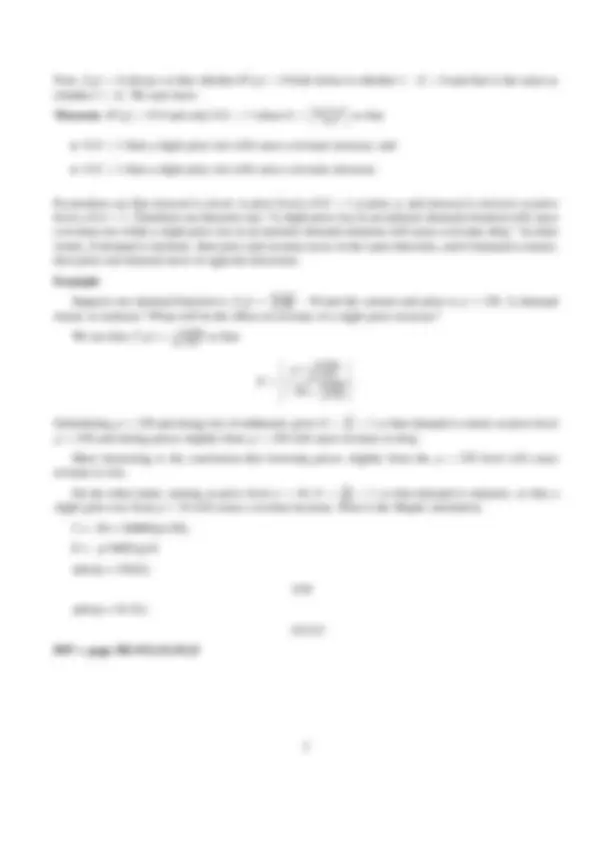



Study with the several resources on Docsity

Earn points by helping other students or get them with a premium plan


Prepare for your exams
Study with the several resources on Docsity

Earn points to download
Earn points by helping other students or get them with a premium plan
Community
Ask the community for help and clear up your study doubts
Discover the best universities in your country according to Docsity users
Free resources
Download our free guides on studying techniques, anxiety management strategies, and thesis advice from Docsity tutors
The concept of elasticity of demand in economics, focusing on percentage changes in demand and revenue. It covers the relationship between percentage change in demand and percentage change in price, and how elasticity of demand impacts revenue. The document also includes an example calculation using a specific demand function.
Typology: Study notes
1 / 2

This page cannot be seen from the preview
Don't miss anything!


Math 108: Notes on Elasticity of Demand
Percentage increases, Percentage rate of increase
A few months ago, Coca-cola in the second floor vending room of this building cost 75 cents per can.
Starting in September the price was $1 per can. The wrong way to look at this situation is “Twenty-five
cents is not much money, so the increase was small. ” The right way to look at the situation is “Dividing
the increase by the former price shows a 33% price increase and that’s big.” It’s the percentage increase,
not the actual increase, that should worry consumers.
Whenever you have a function y = f (x) relating two quantities, we know that f
′ (x) gives the rate of
change of y compared to x. The
relative rate of change =
f
′ (x)
f (x)
and percentage rate of change = 100 ∗
f
′ (x)
f (x)
Note that these quantities probably depend on the x value you started with and should really be called the
relative and percentage rates of change starting at x.
Elasticity of Demand
Demand for gizmos is sensitive to unit price. An increase in price causes a drop in demand. Suppose
we have a demand equation x = f (p) where p is unit price and x is the number of gizmos that can be sold
at price p. The percentage rate of change in demand is
f
′ (p)
f (p)
This predicts the percentage change in demand corresponding to a price increase of $1, and it is always
negative. Starting at a given price p, raising prices by $1 will result in a percentage increase in price of
100 ∗
1 p
. Economists define elasticity of demand starting at price level p to be the ratio
percentage change in demand
percentage change in price
f ′(p) f (p)
1 p
p ∗ f
′ (p)
f (p)
Why use the absolute value? Because otherwise every entry in a table of demand elasticities would be
negative. Note that because our f
′ (p) < 0, this is exactly the same as the book’s definition E =
−p∗ f ′(p) f (p)
Why Care About Elasticity of Demand?
Recall that our revenue (= income) for selling gizmos is given by
R = Revenue = unit price ∗ number sold = p ∗ f (p)
where p is unit price and f (p) is the demand function. Our real interest is in the question “Will our revenue
rise if we increase prices slightly, starting at price level p?” In other words, is R an increasing function
near p? In still other words, is R
′ (p) > 0?
We use the product rule to find R
′ (p) and throw in some algebraic trickery to show how elasticity of
demand, E, is the key. At one point we will use the fact that
p∗ f ′(p)
f (p)
= −E. Here is the calculation:
′ = p ∗ f
′ (p) + 1 ∗ f (p) = f (p) ∗
p ∗ f
′ (p)
f (p)
= f (p) ∗ (−E + 1 ).
Now f (p) > 0 always so that whether R
′ (p) > 0 boils down to whether 1 − E > 0 and that is the same as
whether 1 > E. We now have:
Theorem: R
′ (p) > 0 if and only if E < 1 where E =
p∗ f ′(p) f (p)
∣ so that
Economists say that demand is elastic at price level p if E > 1 at price p, and demand is inelastic at price
level p if E < 1. Therefore our theorem says “A slight price rise in an inelastic demand situation will cause
a revenue rise while a slight price rise in an inelastic demand situation will cause a revenue drop.” In other
words, if demand is inelastic, then price and revenue move in the same direction, and if demand is elastic,
then price and demand move in opposite directions.
Example
Suppose our demand function is f (p) =
10 , 000 p+ 50
− 30 and the current unit price is p = 150. Is demand
elastic or inelastic? What will be the effect on revenue of a slight price increase?
We see that f
′ (p) =
− 10 , 000 (p+ 50 )^2
so that
p ∗
− 10 , 000
(p+ 50 )^2
10 , 000 p+ 50
Substituting p = 150 and doing lots of arithmetic gives E =
15 8
1 so that demand is elastic at price level
p = 150 and raising prices slightly from p = 150 will cause revenue to drop.
More interesting is the conclusion that lowering prices slightly from the p = 150 level will cause
revenue to rise.
On the other hand, starting at price level p = 10, E =
25 123
< 1 so that demand is inelastic, so that a
slight price rise from p = 10 will cause a revenue increase. Here is the Maple calculation.
f := -30 + 10000/(p+50);
E = - p*diff(f,p)/f;
subs(p = 150,E);
subs(p = 10, E);
HW = page 302 #13,15,19,